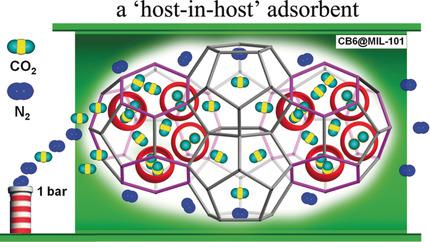当前位置:
X-MOL 学术
›
Angew. Chem. Int. Ed.
›
论文详情
Our official English website, www.x-mol.net, welcomes your
feedback! (Note: you will need to create a separate account there.)
Encapsulation of a Porous Organic Cage into the Pores of a Metal-Organic Framework for Enhanced CO2 Separation.
Angewandte Chemie International Edition ( IF 16.1 ) Pub Date : 2020-02-03 , DOI: 10.1002/anie.201916002 Jun Liang 1, 2 , Alexander Nuhnen 2 , Simon Millan 2 , Hergen Breitzke 3 , Vasily Gvilava 2 , Gerd Buntkowsky 3 , Christoph Janiak 1, 2
Angewandte Chemie International Edition ( IF 16.1 ) Pub Date : 2020-02-03 , DOI: 10.1002/anie.201916002 Jun Liang 1, 2 , Alexander Nuhnen 2 , Simon Millan 2 , Hergen Breitzke 3 , Vasily Gvilava 2 , Gerd Buntkowsky 3 , Christoph Janiak 1, 2
Affiliation

|
We present a facile approach to encapsulate functional porous organic cages (POCs) into a robust MOF by an incipient-wetness impregnation method. Porous cucurbit[6]uril (CB6) cages with high CO2 affinity were successfully encapsulated into the nanospace of Cr-based MIL-101 while retaining the crystal framework, morphology, and high stability of MIL-101. The encapsulated CB6 amount is controllable. Importantly, as the CB6 molecule with intrinsic micropores is smaller than the inner mesopores of MIL-101, more affinity sites for CO2 are created in the resulting CB6@MIL-101 composites, leading to enhanced CO2 uptake capacity and CO2 /N2 , CO2 /CH4 separation performance at low pressures. This POC@MOF encapsulation strategy provides a facile route to introduce functional POCs into stable MOFs for various potential applications.
中文翻译:

将多孔有机笼封装到金属有机框架的孔中以增强二氧化碳分离。
我们提出了一种简便的方法,通过初湿浸渍法将功能性多孔有机笼(POC)封装到坚固的 MOF 中。具有高CO2亲和力的多孔葫芦[6]脲(CB6)笼被成功封装到Cr基MIL-101的纳米空间中,同时保留了MIL-101的晶体框架、形态和高稳定性。封装的CB6量是可控的。重要的是,由于具有固有微孔的 CB6 分子比 MIL-101 的内部中孔更小,因此在所得 CB6@MIL-101 复合材料中产生了更多的 CO2 亲和位点,从而增强了 CO2 吸收能力和 CO2 /N2 、CO2 /低压下的 CH4 分离性能。这种 POC@MOF 封装策略提供了一种简便的途径,可以将功能性 POC 引入稳定的 MOF 中,以实现各种潜在应用。
更新日期:2020-02-14
中文翻译:

将多孔有机笼封装到金属有机框架的孔中以增强二氧化碳分离。
我们提出了一种简便的方法,通过初湿浸渍法将功能性多孔有机笼(POC)封装到坚固的 MOF 中。具有高CO2亲和力的多孔葫芦[6]脲(CB6)笼被成功封装到Cr基MIL-101的纳米空间中,同时保留了MIL-101的晶体框架、形态和高稳定性。封装的CB6量是可控的。重要的是,由于具有固有微孔的 CB6 分子比 MIL-101 的内部中孔更小,因此在所得 CB6@MIL-101 复合材料中产生了更多的 CO2 亲和位点,从而增强了 CO2 吸收能力和 CO2 /N2 、CO2 /低压下的 CH4 分离性能。这种 POC@MOF 封装策略提供了一种简便的途径,可以将功能性 POC 引入稳定的 MOF 中,以实现各种潜在应用。




















































 京公网安备 11010802027423号
京公网安备 11010802027423号